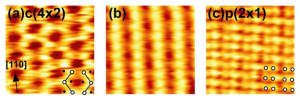研究概要
In our research group, while pushing forward with the development of new nano-measurement techniques using non-contact Atomic Force Microscopes, we search for a new physical phenomenon at solid surfaces. By operating individual atoms and molecules, we also promote the development of future technologies to assemble new nano-materials and new nano-devices.
Main Achievements From Our Research これまでの主な研究業績
“Vertical atomic manipulation with dynamic atomic-force microscopy without tip change via a multi-step mechanism”
Manipulation is the most exciting feature of the non-contact atomic force microscopy technique as it allows building nanostructures on surfaces. Usually vertical manipulations are accompanied by an abrupt tip modification leading to a change of contrast. Here we report on low-temperature experiments demonstrating vertical manipulations of ‘super’-Cu atoms on the p(2×1) Cu(110):O surface, both extractions to and depositions from the tip, when the imaging contrast remains the same. These results are rationalized employing a novel and completely general method that combines density functional theory calculations for obtaining energy barriers as a function of tip height and a Kinetic Monte Carlo algorithm for studying the tip dynamics and extraction of manipulation statistics. The model reveals a novel multistep manipulation mechanism combining activated jumps of ‘super’-Cu atoms to/from the tip with their drag by and diffusion on the tip. : PDF
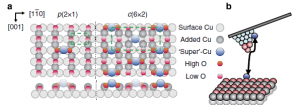
“Investigation of tunneling current and local contact potential difference on the TiO2(110) surface by AFM/KPFM at 78K”
We propose a new multi-image method for obtaining the frequency shift, tunneling current and local contact potential difference (LCPD) on a TiO2(110) surface with atomic resolution. The tunneling current image reveals rarely observed surface oxygen atoms contrary to the conventional results. We analyze how the surface and subsurface defects affect the distribution of the LCPD. In addition, the subsurface defects are observed clearly in the tunneling current image, in contrast to a topographic image. To clarify the origin of the atomic contrast, we perform site-dependent spectroscopy as a function of the tip–sample distance. The multi-image method is expected to be widely used to investigate the charge transfer phenomena between the nanoparticles and surface sites, and it is useful for elucidating the mechanisms of catalytic reactions. : PDF
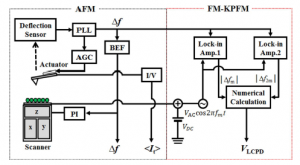
“Investigation of the surface potential of TiO2 (110) by frequency-modulation Kelvin probe force microscopy”
We investigate the surface potential distribution on a TiO2(110)-1×1 surface by Kelvin probe force microscopy (KPFM) and atom-dependent bias-distance spectroscopic mapping. The experimental results demonstrate that the local contact potential difference increases on twofold-coordinated oxygen sites, and decreases on OH defects and fivefold-coordinated Ti sites. We propose a qualitative model to explain the origin of the surface potential of TiO2 (110). We qualitatively calculate the surface potential induced by chemical potential and permanent surface dipole. The calculated results agree with our experimental ones. Therefore, we suggest that the surface potential of TiO2 (110) is dominated not only by the permanent surface dipole between the tip apex atom and surface, but also by the dipoles induced by the chemical interaction between the tip and sample. The KPFM technique demonstrate the possibility of investigation of the charge transfer phenomenon on TiO2 surface under gas conditions. It is useful for the elucidation of the mechanism of the catalytic reactions. : PDF
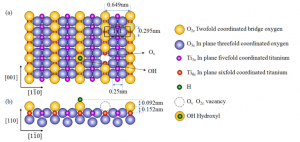
“Growth Models of Coexisting p(2×1) and c(6×2) Phases on Oxygen-Terminated Cu(110) Surface Studied by Noncontact Atomic Force Microscopy at 78 K”
We present an experimental study of coexisting p(2×1) and c(6×2) phases on an oxygen terminated Cu(110) surface by noncontact atomic force microscopy (NC-AFM) at 78 K. Ball models of the growth processes of coexisting p(2×1)/c(6×2) phases on a terrace and near a step are proposed. We found that the p(2×1) and c(6×2) phases are grown from the super Cu atoms on both sides of O-Cu-O rows of an atomic spacing. In this paper, we summarize our investigations of an oxygen-terminated Cu(110) surface by NC-AFM employing O- and Cu-terminated tips. Also, we state several problems and issues for future investigation. : PDF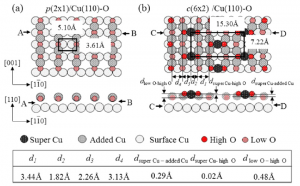
“Atomic force microscopy identification of Al-sites on ultrathin aluminum oxide film on NiAl(110)”
Ultrathin alumina film formed by oxidation of NiAl(110) was studied by non-contact atomic force microscopy in an ultra high vacuum at room temperature with the quest to provide the ultimate understanding of structure and bonding of this complicated interface. Using a very stiff Si cantilever with significantly improved resolution, we have obtained images of this system with unprecedented resolution, surpassing all the previous results. In particular, we were able to unambiguously resolve all the differently coordinated aluminum atoms. This is of importance as the previous images provide very different image patterns, which cannot easily be reconciled with the existing structural models. Experiments are supported by extensive density functional theory modeling. We find that the system is strongly ionic and the atomic force microscopy images can reliably be understood from the electrostatic potential which provides an image model in excellent agreement with the experiments. However, in order to resolve the finer contrast features we have proposed a more sophisticated model based on more realistic approximants to the incommensurable alumina interface. : PDF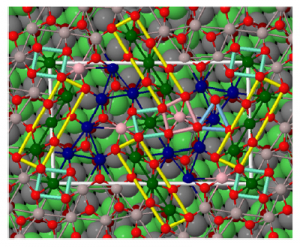
“Surface potential imaging with atomic resolution by frequency-modulation Kelvin probe microscopy without bias voltage feedback”
We investigated the capability of obtaining atomic resolution surface potential images by frequency-modulation Kelvin probe force microscopy (FM-KPFM) without bias voltage feedback. We theoretically derived equations representing the relationship between the contact potential difference and the frequency shift (Δf) of an oscillating cantilever. For the first time, we obtained atomic resolution images and site-dependent spectroscopic curves for Δf and VLCPD on a Si (111)-7×7 surface. FM-KPFM without bias voltage feedback does not involve the influence of the FM-KPFM controller because it has no deviation from a parabolic dependence of Δf on the dc-bias voltage. It is particularly suitable for investigation on molecular electronics and organic photovoltaics, because electron or ion movement induced by dc bias is avoided and the electrochemical reactions are inhibited. : PDF
高感度・高精度に制御できる原子間力顕微鏡
探針(プローブ)と試料表面との間に働く微弱な力を高感度・高精度に制御できる原子間力顕微鏡を開発し、絶縁体表面上で安定かつ再現性のある原子操作に成功した。絶縁性の表面上に新ナノ構造体を構築し、その物性を探索することにより、ナノスケールの新たな機能発現機構を見いだせると期待される。この成果は、2014年の Nature communications に掲載された。 : PDF (from NATURE COMMUNICATIONS)
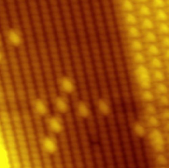
溶液中環境で動作する高速AFM
溶液中環境で動作する高速AFMを開発し、固液表面での力学物性を実験的に解明してきた。溶液中で機能している個々の生体分子を高速に観察できる高速AFMは、生命科学の進展に大きく寄与できる革新的なキーテクノロジーである。この研究では、最も基礎的な物理量であるにもかかわらず、従来、ナノメートルスケールでは測定することが困難であった溶液中環境で動作する高速AFMを開発し、この新しく開発した研究手法を駆使して、固液表面での力学物性を実験的に解明してきた。 : PDF (from APPLIED PHYSICS LETTERS)
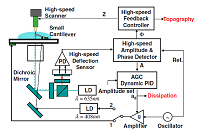
新しいフォース分光法
新しいフォース分光法を開発し、力学的な原子操作の機構を解明することに成功した。Si(001)表面の最安定構造は、c(4×2) 非対称ダイマー構造とされてきた。しかし、極低温において特異なp(2×1)対称ダイマー構造が現れるという実験結果が報告され、その原因は不明であった。本研究では、p(2×1)構造の出現起因を解明することを目的として、5Kで動作する超高真空・非接触AFMを用いて、探針・試料間の相互作用力がどのように影響するかを研究した。 PDF (from PHYSICAL REVIEW LETTERS)
